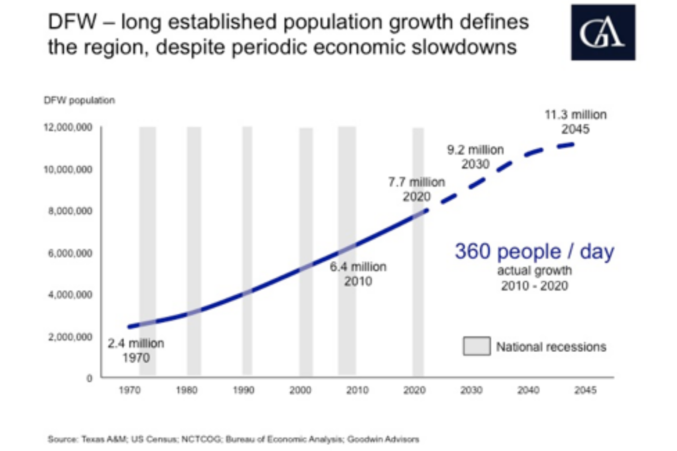As we sit here in mid-2021, it is tempting to look deeper into our economic rebound and try to forecast what the next year or two will be like. That’s a tough task!

Clearly, our economy is in recovery as vaccinations and herd immunity are allowing us to re-open. For real estate, the housing market is white-hot, and people are returning to the office, as well as shopping in bricks and mortar, having dinner out, traveling, and staying in hotels again. Those are all steps toward a return to normal. While there will likely be some lasting shifts, they are impossible to forecast at this time – such as the real impact a hybrid office and remote work model will have on the office sector.
Putting these near-term challenges aside, some interesting DFW numbers have recently come out. Among them, the Census pegged 2020 population growth at 120,000. Even in the midst of the pandemic, that mirrors the scale of annual growth we’ve seen for several years. Experts also expect our population to hit 9 to 9.5 million by 2030. Again, that growth rate is consistent with our longer-term trends.
What’s important here is that DFW’s growth has been consistent over the decades – even after accounting for the inevitable national economic slowdowns, like the one we are presently working through. The reasons for this resilience are well documented and include – our pro-business environment, comparatively low cost of doing business and cost of living, high quality of life, and a diverse and well-educated labor pool, as well as our can-do attitude.

Because of these underlying strengths, there is no reason to expect this outlook to shift materially. What is important, though, is to understand the impacts this growth will bring. To achieve this scale, we will need more housing and more industrial, office, and retail space to serve the needs of our expanding population.
In looking at this idea, we examined DFW’s built environment, how much housing and commercial space we have to serve our current population, and how much more we might need to accommodate our growth. To understand the magnitude of change ahead, we examined our Council of Government’s 2045 forecast. That outlook anticipates DFW will add about 3.5 million people, on top of our current 7.7 million base.
This growth translates into slightly more than 1.5 million new households. I find it astounding that we will need 184,000 acres of single-family homes, townhouses, condos, and apartments for these new residents! That’s close to 300 square miles.
This growth also will generate demand for supporting commercial uses, including industrial space, office buildings, and a range of retail shopping, restaurants, and entertainment options. For example, in looking at industrial, our current base suggests we will need to build more than 300 million square feet of new development to support our growth – transforming another 27,000 acres into built space. The chart below highlights these development and land requirements. As an aside, 40 percent of this new demand will be needed by 2030.

Why is this important? The issue is that we must proactively guide this development to manage our current and future resources. The easiest thing is to let new development happen, pushing DFW’s built edges even further out. With our metro region the size of the state of Connecticut, the question we need to ask is, do we want to continue to advance those boundaries to the horizon?
Maybe. That’s one approach – and maybe a sound plan in some emerging locations like our northern suburbs served by a solid highway system.
In looking at our longer-term future, however, we may need to assess how we accommodate regional growth. Re-development, re-purposing, and re-use in established areas might be a more strategic solution. The catch is that this all may need to happen at higher densities than we are now accustomed to. As an illustration, that likely means higher-density single-family than the popular four to five dwelling units per acre, as well as embrace a greater share of townhouses and more multifamily at notably higher densities.
This growth will bring greater traffic. While adding lanes and roads is what we’ve done in the past, we can’t build enough to accommodate all these people. That means we need to expand reliable and fast public transit that serves the urban core – and the suburbs. Many of us, including our kids, will have to adopt this new way of getting around. We also will need to get a handle on improving our urban schools, getting them to a better place – but that is a potential future blog topic.
The last important takeaway is that this transformational growth we are headed for will take place gradually. Little by little, our region will stretch its boundaries, leading to more congestion and challenged resources. Because of that, community discussions and planning need to take place now to ensure we remain competitive and realize our future prosperity.
Walt Bialas is a senior partner at Goodwin Advisors.





